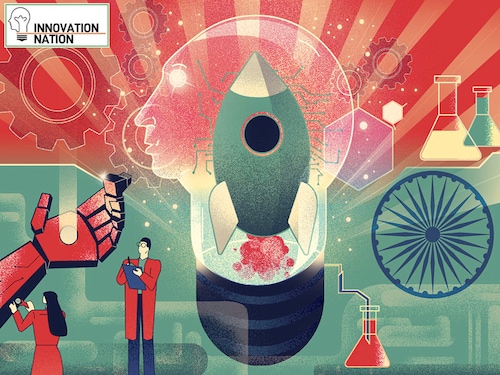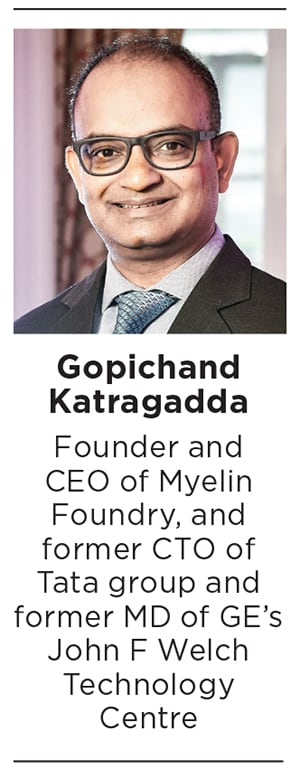India has the potential to create global-first products. What will it take to un
Gopichand Katragadda, the founder of Myelin Foundry, and former CTO of Tata group says India has all the ingredients needed to innovate high-tech products for the world


If you look at the Consumer Electronics Show (CES), one of the world’s largest and most influential technology trade shows that showcases cutting-edge consumer electronics and innovation from major tech companies, you’ll see a growing number of Indian product companies participating.
The show offers a platform for businesses to demonstrate their latest products and technologies, network with industry leaders, and gain exposure to a global audience.
 At CES 2023, Indian companies had products on display, including advanced audio systems, AR/VR devices, and health care implant simulation software. At CES 2022, my startup Myelin Foundry had a video enhancement product on display, in addition to other products from India, including smart homes, smart metering and wellness.
At CES 2023, Indian companies had products on display, including advanced audio systems, AR/VR devices, and health care implant simulation software. At CES 2022, my startup Myelin Foundry had a video enhancement product on display, in addition to other products from India, including smart homes, smart metering and wellness.
India has the capability but still has a distance to cover and make an impact with globally recognised innovative consumer products. In industrial products as well, India has made a few contributions such as in commercial and passenger vehicles. Our defence exports are on the rise, touching $2 billion, and can grow ten-fold if innovation is added to our engineering capabilities.
India has even more in terms of raw capacity to deliver global-first products. It has several of the ingredients required to produce them, including an innovative talent pool and a growing market. There are, however, areas where India falls short, such as being a lead market with the spirit to fund and use new technologies.
To enable global-first product development at a national scale, the required ecosystem includes large corporations with research excellence, talent from deep-tech startups, high-quality research from academic institutions, and a conducive regulatory environment.
The arrowhead for global-first products are corporations with an ability to invest in R&D and with innovation as their DNA. The top R&D investing countries in terms of GDP in 2021 were South Korea, Israel, Japan, Switzerland and the US. These countries invest 3.25-4.25 percent of GDP in R&D.
Our R&D investments are 0.7 percent of GDP, of which a significant amount comes from the government. We need to increase the R&D investments to at least 2 percent of GDP. A significant percentage of that growth should come from the industry. India has many large corporations with the ability to invest in R&D. However, they have R&D programmes that are fragmented or short-term.
Businesses that have grown up with a services mindset might not have the ability to shift to a product mindset. Existing product-oriented companies such as in the automotive space need to grow global ambitions. We need to build new global companies in health care and energy management harnessing our population, demography and digital prowess.
Having worked with researchers at GE and the Tata group for 17 years, and with my current startup team for four years, I believe India has one of the best talent pools globally. The younger generation is confident, collaborative and digital native. They are comfortable with technologies such as AI and edge computing. A combination of confident experts and youthful energy is critical for deep tech companies.
A deep tech company is characterised by global-first products with a gestation period of more than five years. Typically, deep tech company founders have industry experience of more than 10 years and often possess advanced degrees. We have a few good deep tech VCs who have contributed to technology globally and chosen to produce global stars in terms of startup companies from India.
India has institutions of national pride such as the IIT, IIMs and the Indian Institute of Science (IISc). Specific institutions have been recognised in the global top 400 for research excellence. India should aim to have four or five institutions in the top 50 research institutions globally and each of those should become a hub for innovation like Stanford is for Silicon Valley and MIT is for the Boston area.
The IITs and IISc have research parks and startup incubators that are good starting points. Each hub needs to connect and create a local ecosystem for innovation. Taking Bengaluru as an example, the IISc has incubated more than 60 startups and has contributed to several more. Beyond IISc, we need to have a stronger research ecosystem, including the Council for Scientific and Industrial Research (CSIR) & Defence Research and Development Organisation (DRDO) labs and upcoming research capabilities in engineering institutions like RVCE, PES and Amrita. Also, the nearby town of Mysuru has fantastic capabilities to be leveraged in organisations like CFTRI and several engineering colleges.
From occupancy certificates and environmental permits to tax matters, research grants & projects and VC funding-related compliances, there are many aspects of a startup that get impacted by governance. Good state governments have attracted global investments in technology and have been able to attract entrepreneurial and technical talent. Karnataka and Telangana have demonstrated the ability to provide ecosystems of sustained good governance.
There have also been many recent central government initiatives that have been based on industry inputs, including programs like BIRAC, TDF, and DISC, which are allocating funds for R&D to startups. In Budget 2023, Finance Minister Nirmala Sitharaman has announced three centres of excellence for AI in top educational institutions and 100 labs in engineering institutions for developing 5G applications. These are great moves, and success will depend on detailed execution and monitoring.
As we solve for the India market opportunities of $100 billion a year each in energy, health and mobility, we should produce global-first products that solve local challenges and are also marketable globally. It is not just about being on the top of the value chain, but also about pulling our weight in a new world where we solve for human health and comfort while minimising the impact on our planet.
First Published: Feb 27, 2023, 11:55
Subscribe Now